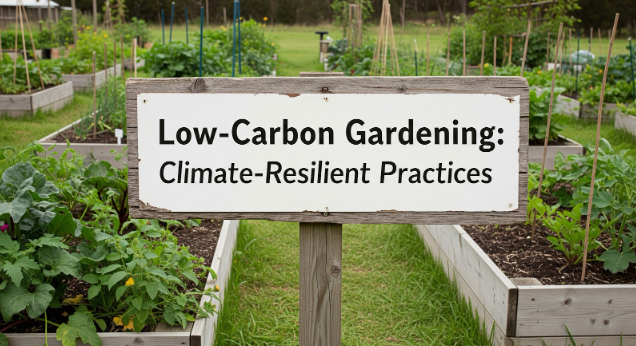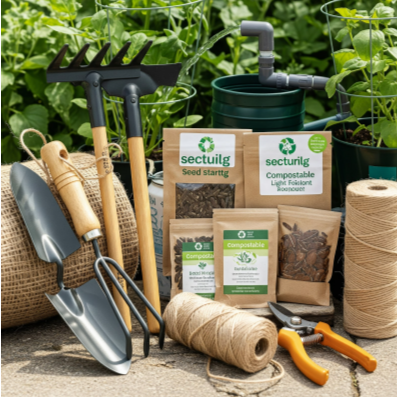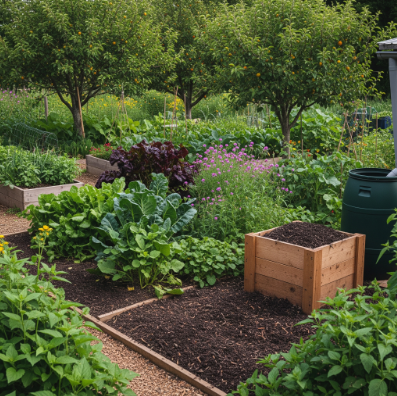
As climate change becomes more urgent in 2025, gardeners are stepping up to become environmental stewards. Traditional gardening practices—though beautiful—can have a significant carbon footprint through the use of synthetic fertilizers, overwatering, and non-native plants. In contrast, low-carbon gardening is an eco-conscious approach that minimizes emissions, protects natural resources, and builds resilience against extreme weather.
Climate-smart gardening is not just about growing plants—it’s about growing responsibly. From sourcing local materials to selecting drought-tolerant species, each decision you make can help fight climate change. Low-Carbon Gardening: Climate-Resilient Practices method of gardening reduces reliance on fossil fuels, lowers greenhouse gas emissions, and increases biodiversity. It empowers gardeners to take direct action in the face of global environmental challenges.
This movement is especially crucial for urban dwellers and those with limited space. Rooftop gardens, balconies, and small yards can become powerful micro-habitats that sequester carbon, cool surrounding areas, and promote ecological balance. Low-carbon gardening is accessible to everyone, regardless of skill level or location.
Whether you have a backyard, rooftop garden, or small patio setup, you can make your garden part of the climate solution. This guide explores practical strategies, tools, and plant choices that support sustainable, climate-resilient gardening in any space.
What is Low-Carbon Gardening?
Low-Carbon Gardening: Climate-Resilient Practices refers to the practice of designing, growing, and maintaining a garden in a way that reduces greenhouse gas emissions. This means:

- Choosing materials with a low carbon footprint: Opt for locally sourced, recycled, or upcycled materials that require less energy to produce and transport. Avoid using plastic pots or chemically treated wood in favor of clay, bamboo, or reclaimed wood. This helps reduce emissions associated with manufacturing and logistics.
- Avoiding chemical fertilizers and peat-based soil products: Synthetic fertilizers are typically derived from fossil fuels and contribute to nitrous oxide emissions—a potent greenhouse gas. Peat extraction also releases stored carbon into the atmosphere. Choose alternatives like compost, manure, and worm castings to enrich soil naturally.
- Using water efficiently: Watering with intention helps save both energy and resources. Implement drip irrigation systems, rainwater harvesting, and mulching to maintain soil moisture. Watering early in the morning or late in the evening also minimizes evaporation loss.
- Enhancing soil to store more carbon: Healthy soil acts as a carbon sink. Add organic matter like compost, cover crops, or mulch to increase microbial life and carbon storage capacity. No-dig gardening also maintains soil structure, minimizing disruption to the underground ecosystem.
- Supporting biodiversity through native planting: Native plants are well-adapted to local climates and require fewer resources. They attract beneficial insects, pollinators, and wildlife, creating a thriving mini-ecosystem. This not only boosts biodiversity but also reduces dependency on pesticides and synthetic fertilizers
Healthy Soil
Healthy soils can store carbon, while well-designed gardens can cool local environments, reduce stormwater runoff, and support wildlife habitats.
It also emphasizes sourcing local materials, minimizing waste, and creating self-sustaining ecosystems. Gardeners can reduce reliance on imported products and fossil fuels by growing food locally, thereby cutting down on transportation emissions. Low-carbon gardening is not only good for the planet but also contributes to healthier, more resilient communities and ecosystems. Low-Carbon Garden Design Basics
A well-designed garden minimizes the need for external resources. Focus on:
- Site Planning: Maximize natural sunlight and airflow. Avoid high-maintenance turf.
- Plant Layering: Incorporate trees, shrubs, and ground covers to mimic nature.
- Native Plants: These require less water and fertilizer while attracting local pollinators.
- Reduce Hardscape: Limit concrete or synthetic mulch. Use permeable materials like gravel or reclaimed brick.
- Zone Appropriately: Group plants with similar light and water needs together.
Design with function and efficiency in mind. Raised beds and container gardens can help manage soil quality while improving accessibility. You can also integrate passive solar techniques—placing larger plants to provide shade for smaller ones and reduce watering needs. Every design element should serve multiple ecological purposes for a truly low-carbon setup.
Low-Carbon Gardening: Choosing Climate-Resilient Plants
In an era of unpredictable weather patterns and increasing climate stress, choosing climate-resilient plants is more important than ever. These plants are naturally adapted to thrive in challenging environmental conditions, such as heatwaves, droughts, heavy rains, and fluctuating temperatures. By integrating these hardy varieties into your garden, you can ensure long-term growth, reduce maintenance, and conserve valuable resources like water and fertilizer.
Why Climate-Resilient Plants Matter for Low-Carbon Gardening
Climate-resilient plants not only survive but flourish with minimal intervention. They are more resistant to pests and diseases, require less watering, and can better adapt to seasonal changes. Choosing these plants supports biodiversity and helps create a stable ecosystem in your garden.
What to Look For
When selecting plants, consider the following characteristics:
- Drought Tolerance: Plants like lavender, sedum, yarrow, and ornamental grasses are excellent in dry conditions.
- Heat Resistance: Species such as zinnias, coneflowers, and succulents can withstand high temperatures.
- Cold Hardiness: Look for plants that are rated for your hardiness zone and can handle unexpected frosts.
- Flood Tolerance: Some plants, like elderberry and swamp milkweed, can endure occasional waterlogging or heavy rains.
- Native Species: Local native plants are naturally suited to your region’s climate and soil, making them ideal for resilience.
Examples of Climate-Resilient Plants
- Perennials: Coneflowers, black-eyed Susans, and Russian sage.
- Shrubs: Serviceberry, viburnum, and juniper.
- Trees: Red maple, ginkgo, and bur oak.
- Groundcovers: Creeping thyme, ice plant, and vinca.
Practical Tips for Low Carbon Gardening
- Group plants by their water and sunlight needs.
- Incorporate mulch to retain moisture and regulate soil temperature.
- Regularly update your plant choices based on shifting weather patterns and hardiness zone changes.
Choosing Climate-Resilient Plants
By choosing climate-resilient varieties, you ensure your garden can thrive with less water, reduced intervention, and lower maintenance. Look for species adapted to your local hardiness zone, and consider interplanting to enhance pest resistance and improve biodiversity. Climate-smart plants reduce your reliance on fossil-fuel-powered interventions like irrigation, fertilizers, and pest control, helping to lower your overall environmental impact.
Composting & Organic Soil Practices for Low Carbon Gardening
Healthy soil is the cornerstone of low-carbon gardening:
- Composting: Turn food scraps and garden waste into nutrient-rich humus.
- Vermicomposting: Use worms to accelerate composting and create potent castings.
- Bokashi: Anaerobic composting system suitable for small spaces.
- Avoid Peat Moss: It’s a major carbon emitter; use coco coir or compost instead.
These methods not only enrich the soil but also divert organic waste from landfills, reducing methane emissions. Building organic matter increases the soil’s ability to store carbon and retain water, making your garden more self-sustaining. You can also make compost tea to boost microbial life and replace synthetic fertilizers. Proper composting is both an act of waste reduction and a vital soil-building technique in climate-resilient gardening.

Water is precious. Here’s how to make every drop count:
- Drip Irrigation: Directs water to roots, reducing evaporation. This system delivers water slowly and directly to plant roots, minimizing waste and preventing runoff. It’s ideal for container gardens, vegetable beds, and landscapes where water conservation is a priority.
- Rain Barrels: Harvest and store water for dry days. Installing a rain barrel under a downspout allows you to collect and reuse rainfall for your garden. This method reduces demand on municipal water systems and provides plants with naturally soft, chlorine-free water.
- Mulching: Keeps soil cool and reduces watering needs. A thick layer of organic mulch—like straw, wood chips, or shredded leaves—protects the soil from evaporation, suppresses weeds, and gradually enriches soil as it decomposes.
- Soil Health: Organic matter increases water retention naturally. Amending soil with compost improves its structure and moisture-holding capacity. Healthy soil not only holds more water but also helps plants access nutrients more efficiently, reducing the need for chemical inputs.
Smart watering keeps your garden resilient through heatwaves and droughts.
You can also reuse greywater from showers or laundry for irrigation (where regulations allow). Choose watering times strategically—early morning or late evening—to minimize evaporation. Use moisture sensors or install rain gauges to monitor water use efficiently. These simple adjustments significantly cut down on waste and contribute to a more eco-conscious gardening routine.
Tools and Materials with a Light Footprint
Reduce embodied carbon in your garden supplies:
- Use Hand Tools: Avoid gas-powered or electric where possible. Manual tools like hoes, rakes, and pruners not only save energy but also last longer when well maintained. They reduce reliance on fossil fuels, create less noise pollution, and encourage a more mindful, slower gardening rhythm.
- Recycled Pots and Wood: Repurpose materials creatively. Instead of buying new containers, reuse old buckets, crates, or even broken kitchenware. Salvaged wood from pallets or discarded furniture can be transformed into raised beds, trellises, or borders, saving resources and minimizing landfill waste.
- Buy Local: Reduce emissions from shipping garden products. Supporting local nurseries, hardware stores, or artisans not only strengthens your community economy but also cuts down transportation-related carbon emissions. Local materials are often better adapted to your climate and soil conditions as well.
- Choose Durable: Invest in long-lasting tools and infrastructure. Select high-quality stainless steel or wooden-handled tools, weather-resistant raised beds, and UV-resistant irrigation lines. Though these items might cost more initially, their longevity reduces the need for frequent replacement, lowering your garden’s overall footprint.

Solar-powered lights, bamboo trellises, and reclaimed metal decor also reduce environmental impact.
Avoid single-use plastics and opt for biodegradable alternatives whenever possible. Repair broken tools instead of replacing them, and buy secondhand items to extend their life cycle. Supporting local artisans and makers for tools and accessories also reduces transportation emissions while encouraging community resilience. These mindful choices reduce waste and align with the core values of low-carbon gardening.
Tracking Your Garden’s Carbon Impact
Stay aware of your garden’s footprint by:
- Keeping a Garden Journal: Track inputs like water, compost, fertilizer use. Logging your daily or weekly activities helps you monitor progress, catch inefficiencies, and adjust your practices over time. Record plant health, weather patterns, watering frequency, and compost output to identify trends and areas for improvement.
- Using Apps: Carbon calculators and planting planners help evaluate sustainability. Apps like My Green Space, Gardenize, or GrowVeg can help estimate your garden’s carbon offset by measuring plant types, compost contributions, and reductions in waste. These tools also provide planting calendars and alerts for more efficient scheduling.
- Observing Nature: Healthy soil, pollinator presence, and low runoff are good signs. Nature gives visual and biological feedback. Earthworms, bees, butterflies, and birds indicate a thriving ecosystem. Minimal runoff after rain means your soil is absorbing water effectively, reducing erosion and nutrient loss.
Regularly tracking your garden’s impact empowers you to make smarter decisions and contribute more meaningfully to climate resilience.
Tracking your garden’s data not only helps you make improvements but also motivates eco-friendly habits. Use smartphone apps or spreadsheets to note trends in plant health, water usage, and waste reduction. Over time, this documentation helps you refine your techniques and measure your garden’s environmental contributions. Sharing this data with local communities or gardening groups can also inspire wider climate-positive actions.
Even small reductions in your inputs can make a meaningful environmental impact.
“Tips for Successful Transplanting”
The Bigger Picture: Regenerative Gardening
Beyond reducing carbon, regenerative gardening aims to improve ecosystems:
- Soil Restoration:
No-till practices and cover crops build soil life. Healthy soils teeming with microbial activity not only sequester carbon but also support plant resilience. By avoiding tilling and integrating organic matter, you preserve soil structure, moisture, and nutrient cycling—crucial elements in combating climate stress.
Connect your garden to others for pollinators and birds. Establishing green pathways using flowering plants, hedgerows, or wildflower strips helps pollinators and other wildlife move safely across landscapes. These corridors create continuity between urban and rural green spaces and promote biodiversity.
- Seed Saving:
Preserve climate-resilient plant genetics. Saving seeds from thriving plants ensures future generations are well adapted to your local environment. This practice protects heirloom varieties, reduces dependency on commercial seed systems, and encourages biodiversity in home gardens.
- Community Sharing:
Exchange compost, seeds, and resources locally. Regenerative gardening thrives in community. Swapping soil amendments, garden tools, and homegrown produce reduces consumption, fosters cooperation, and strengthens social bonds. Community composting hubs or seed libraries are excellent examples of how local sharing contributes to regenerative systems.
Your Low-Carbon Gardening: Climate-Resilient Practices can inspire others to act and foster resilience in your community.
Regenerative gardening goes beyond sustainability—it actively heals damaged ecosystems and promotes biodiversity. It’s about putting more back into the land than you take out. This could mean letting part of your garden rewild, planting trees, or fostering a thriving mycorrhizal network beneath your soil. When practiced on a broader scale, regeneration can transform entire neighborhoods into green, climate-resilient zones that benefit both people and the planet.

It also fosters deeper connections between individuals and their environment, reviving cultural traditions such as seed stewardship, communal harvests, and land-based rituals. Regenerative gardening encourages long-term thinking and ecological mindfulness, promoting intergenerational learning and responsibility. By modeling this approach, your garden becomes not only a tool for healing the Earth but a living classroom and spiritual refuge that enriches every part of life.
Low-Carbon Gardening: Climate-Resilient Change Action Checklist
Sustainable Low Carbon Gardening: Climate-Resilient Practices is not about perfection—it’s about progress. Every eco-conscious decision you make supports the planet and builds resilience in your outdoor space.
As the climate continues to change, your garden can become a living example of environmental stewardship. Low Carbon Gardening, It’s a space where mindful practices not only help restore the earth but also enhance your own wellbeing. By choosing low-carbon materials, water-wise techniques, composting habits, and regenerative design, you actively participate in a global movement for greener living.
A Low-Carbon Gardening: Climate-Resilient Practices also encourages connection—with the land, the seasons, and your local community. Whether you’re planting native perennials or sharing compost with neighbors, your choices have ripple effects. This form of climate activism is tangible, rewarding, and deeply rooted in the rhythms of nature.
Plantingwell.com is a dedicated gardening and organic farming website offering practical tips, how-to guides, and eco-friendly solutions for plant lovers of all levels. Whether you’re growing vegetables, herbs, flowers, or exploring sustainable farming techniques, PlantingWell.com provides expert advice on soil health, fertilizers, watering, pest control, and seasonal care. Our mission is to help you grow healthier plants while supporting environmentally responsible gardening practices.

